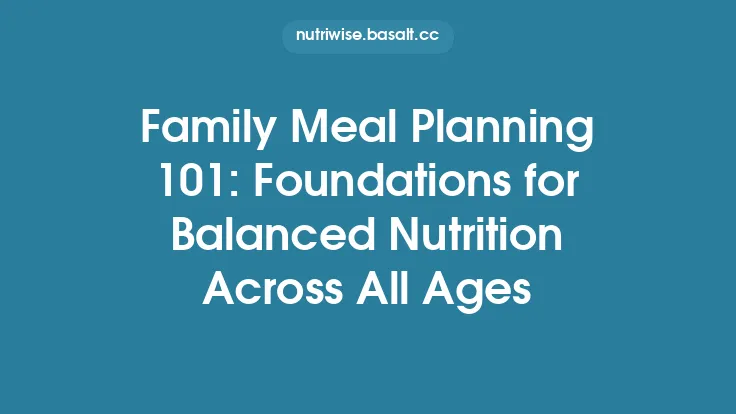Micronutrients—vitamins, minerals, and trace elements—are the silent architects of health. While a single meal can provide a burst of specific nutrients, true wellness hinges on a steady, day‑to‑day supply that matches the body’s ongoing demands. Achieving this consistency isn’t about occasional “superfood” meals; it’s about embedding purposeful, repeatable strategies into the very fabric of your weekly menu. Below is a comprehensive guide to meal‑planning tactics that keep micronutrient intake reliable, balanced, and adaptable to any lifestyle.
Why Consistency Beats Occasional Abundance
A diet that sporadically hits high micronutrient levels can create short‑term spikes followed by periods of deficiency. The body’s enzymatic processes, immune function, and cellular repair mechanisms rely on a continuous supply of cofactors—most of which are micronutrients. When intake fluctuates wildly, homeostatic systems must compensate, often at the cost of efficiency and long‑term health. Consistent coverage helps:
- Maintain optimal enzyme activity (e.g., B‑vitamins as coenzymes)
- Support stable hormone production (e.g., iodine for thyroid hormones)
- Preserve bone health (e.g., calcium, magnesium, vitamin D)
- Sustain immune readiness (e.g., zinc, selenium, vitamin C)
Setting Personal Micronutrient Targets
Before you can plan, you need a benchmark. The Recommended Dietary Allowances (RDAs) and Adequate Intakes (AIs) provide population‑based targets, but individual needs vary based on age, sex, activity level, health status, and life stage (e.g., pregnancy). Follow these steps:
- Gather Baseline Data – Use a recent blood panel, health questionnaire, or a reputable online assessment to identify any known deficiencies or heightened needs.
- Select Reference Values – Pull the RDA/AIs for each micronutrient relevant to your profile. For example, adult men typically need 11 mg of iron per day, while premenopausal women need 18 mg.
- Prioritize – Flag nutrients that are most likely to be limiting in your current diet (e.g., vitamin D in higher latitudes, magnesium in high‑stress periods).
- Create a Simple Spreadsheet – List each micronutrient, its target amount, and a column for daily intake. This becomes your “micronutrient budget” that you’ll fill in each week.
Building a Balanced Meal Template
A template is a repeatable skeleton that ensures each meal contributes a slice of the overall micronutrient pie. Think of it as a “nutrient‑balanced plate” rather than a “food‑balanced plate.” A practical template might look like this:
| Meal | Core Component (Protein/Legume) | Vegetables (Color Group) | Whole‑Grain/Complex Carb | Healthy Fat | Optional Micronutrient Boost |
|---|---|---|---|---|---|
| Breakfast | Eggs, tofu, or Greek yogurt | Spinach or kale (green) | Oats or whole‑grain toast | Avocado or nuts | Fortified plant milk |
| Lunch | Grilled chicken, tempeh, or beans | Red bell pepper or beet (red) | Quinoa or brown rice | Olive oil drizzle | Sprouted seeds |
| Dinner | Salmon, lentils, or lean beef | Orange carrots or sweet potato (orange) | Sweet potato or barley | Flaxseed oil | Fermented side (kimchi) |
| Snack | Cottage cheese or hummus | Mixed berries (purple/blue) | Whole‑grain crackers | Nut butter | Vitamin‑C‑rich fruit slice |
Key Principles
- Protein/Legume Base supplies iron, zinc, B‑vitamins, and essential amino acids.
- Color Group Vegetables guarantee a spectrum of phytonutrients, each linked to specific vitamins/minerals (e.g., orange carrots → β‑carotene → vitamin A).
- Complex Carbohydrate adds B‑vitamins and minerals like magnesium and selenium.
- Healthy Fat enhances absorption of fat‑soluble vitamins (A, D, E, K).
- Optional Boost allows you to address any shortfall identified in your micronutrient budget.
By rotating the specific items within each column, you maintain variety while preserving the nutrient framework.
The Role of Food Variety and Color
Color is a visual cue for phytochemical diversity. While the “rainbow plate” concept is common, applying it systematically to meal planning ensures you’re not just adding color for aesthetics but for targeted micronutrient coverage.
| Color | Representative Foods | Dominant Micronutrients |
|---|---|---|
| Red | Tomatoes, red cabbage, pomegranate | Vitamin C, lycopene, potassium |
| Orange/Yellow | Sweet potatoes, pumpkin, corn | β‑carotene (vitamin A), folate |
| Green | Broccoli, kale, peas | Vitamin K, folate, magnesium |
| Blue/Purple | Blueberries, eggplant, blackberries | Anthocyanins, vitamin C, manganese |
| White/Brown | Cauliflower, mushrooms, onions | Selenium, potassium, B‑vitamins |
Implementation Tip: Assign each day of the week a “color focus” and ensure at least two servings of that color appear across meals. This systematic approach reduces the chance of missing out on any particular micronutrient cluster.
Weekly Rotation Systems
Even with a solid template, monotony can creep in, leading to nutrient gaps. A rotation system spreads foods across a 2‑ to 4‑week cycle, guaranteeing exposure to a broader nutrient pool.
- Create a Master List – List 12–16 protein sources, 20–30 vegetable varieties, and 8–10 whole‑grain or starchy options.
- Assign Weeks – Week 1 might feature legumes and leafy greens; Week 2 swaps in fish and cruciferous vegetables; Week 3 introduces poultry and root vegetables, and so on.
- Cross‑Reference with Micronutrient Gaps – After each week, review your spreadsheet. If iron intake fell short, prioritize iron‑rich foods (e.g., lentils, spinach) in the next rotation.
The rotation also mitigates the risk of developing food sensitivities and keeps meals exciting.
Batch Cooking and Portion Control
Batch cooking is the engine that drives consistency. By preparing large quantities of nutrient‑dense components ahead of time, you eliminate the daily decision fatigue that often leads to suboptimal choices.
- Batch‑Cook Core Proteins – Roast a tray of mixed beans, grill a batch of chicken breasts, or poach a pot of salmon. Portion into individual containers (e.g., 4‑oz servings) for quick assembly.
- Pre‑Portion Vegetables – Steam or roast a mix of vegetables, then divide into daily servings. Freeze portions that won’t be used within three days to preserve nutrients.
- Create “Micronutrient Packs” – Small bags containing a specific micronutrient boost (e.g., a tablespoon of pumpkin seeds for zinc, a handful of dried apricots for iron) can be added to any meal.
Portion control ensures you meet—not exceed—your micronutrient targets, preventing both deficiencies and excesses (e.g., hypervitaminosis A from overconsumption of liver).
Leveraging Technology for Nutrient Tracking
Modern tools can automate much of the bookkeeping involved in micronutrient planning.
- Nutrition Analysis Apps – Apps like Cronometer, MyFitnessPal (premium), or NutritionData allow you to log meals and instantly see micronutrient breakdowns.
- Custom Spreadsheet Templates – Build a Google Sheet with built-in formulas that pull data from the USDA FoodData Central API. This gives you real‑time nutrient totals for each day.
- Meal‑Planning Platforms – Services such as Eat This Much or PlateJoy let you set micronutrient goals and generate weekly menus that meet them.
- Smart Kitchen Devices – Some connected scales and food scanners can identify nutrient content on the fly, feeding data directly into your tracking app.
Set a weekly reminder to review your nutrient totals. If any micronutrient consistently falls below 80 % of its target, adjust the upcoming menu accordingly.
Incorporating Fortified Foods and Supplements Wisely
Even the most varied whole‑food diet can miss certain nutrients, especially in restrictive eating patterns (e.g., vegan, gluten‑free) or during life stages with heightened needs (e.g., pregnancy). Fortified foods and supplements can fill these gaps without overhauling your meal plan.
- Fortified Plant Milks – Often enriched with calcium, vitamin D, and B12.
- Breakfast Cereals – Many are fortified with iron, folic acid, and various vitamins.
- Targeted Supplements – A daily multivitamin can serve as a safety net; however, choose formulations that avoid excessive upper‑limit doses (e.g., keep vitamin A below 3,000 µg RAE per day unless prescribed).
Document any fortified items or supplements in your tracking system to avoid double‑counting.
Adapting Plans for Life Stages and Special Needs
Micronutrient requirements shift dramatically across the lifespan and with specific health conditions.
| Population | Notable Micronutrient Concerns | Planning Adjustments |
|---|---|---|
| Children (2‑12 y) | Calcium, vitamin D, iron | Include dairy or fortified alternatives, lean red meat, and iron‑rich legumes. |
| Adolescents | Iron (especially females), zinc, B‑vitamins | Emphasize lean meats, whole grains, and nuts. |
| Pregnant/Breastfeeding | Folate, iron, iodine, DHA | Add prenatal supplement, incorporate seaweed (iodine), and fatty fish (DHA). |
| Older Adults | Vitamin B12, vitamin D, calcium, magnesium | Prioritize fortified foods, low‑fat dairy, and consider B12 sublingual tablets. |
| Athletes | Electrolytes (magnesium, potassium), vitamin C | Include electrolyte‑rich fruits, nuts, and post‑exercise recovery shakes. |
| Vegans | Vitamin B12, iron, zinc, calcium, DHA/EPA | Use fortified plant milks, B12 supplement, and algae‑derived DHA/EPA. |
When you know the demographic you’re serving, embed the specific adjustments directly into your meal template and rotation schedule.
Budget‑Friendly Strategies
Micronutrient‑rich eating doesn’t have to be expensive. Here are cost‑saving tactics that preserve nutrient density:
- Buy in Bulk – Dried beans, lentils, and whole grains are inexpensive per gram of protein and mineral content.
- Seasonal Produce – Even though we’re not focusing on “seasonal superfoods,” purchasing vegetables at peak season reduces price and often improves nutrient levels.
- Utilize Frozen Options – Frozen berries, spinach, and peas retain most vitamins and minerals while being cheaper than fresh out‑of‑season varieties.
- Grow Your Own Herbs – Basil, parsley, and cilantro are rich in vitamin K and antioxidants; a small windowsill garden can supply a steady stream.
- Make “Nutrient Concentrates” – Blend a batch of carrot‑sweet potato puree (high in beta‑carotene) and freeze in portioned containers for quick addition to soups or stews.
Track food costs alongside nutrient totals in your spreadsheet to identify the most cost‑effective nutrient sources.
Storage and Shelf‑Life Considerations
Micronutrients degrade over time, especially when exposed to light, heat, and oxygen. Proper storage maximizes the nutritional return on your grocery spend.
- Cool, Dark Places – Store potatoes, onions, and winter squash in a pantry away from direct sunlight.
- Refrigeration – Leafy greens and berries should be kept in the crisper drawer, ideally in perforated bags to reduce moisture buildup.
- Freezing – Blanch vegetables (e.g., broccoli, green beans) for 2–3 minutes before freezing to lock in vitamin C and folate.
- Airtight Containers – Keep nuts, seeds, and whole grains in sealed jars to prevent oxidation of vitamin E and essential fatty acids.
- Rotate Stock – Use the “first‑in, first‑out” method to ensure older items are consumed before newer ones, minimizing nutrient loss.
Evaluating and Adjusting Your Plan
A static plan will eventually drift from optimal coverage. Implement a quarterly review cycle:
- Data Review – Export your nutrient tracking data for the past month and calculate average percentages of each target.
- Identify Trends – Look for consistently low or high nutrients. For example, if magnesium averages 60 % of the RDA, plan to add more nuts, seeds, or whole grains.
- Modify the Template – Swap out a protein source or vegetable to address the gap.
- Re‑test – After implementing changes, monitor the next month’s data to confirm improvement.
If you have access to periodic blood work, compare lab results with dietary data for a more precise feedback loop.
Common Pitfalls and How to Avoid Them
| Pitfall | Why It Happens | Solution |
|---|---|---|
| Relying on a Single “Superfood” | Belief that one food can cover all needs | Use a variety of foods; rotate colors and groups |
| Ignoring Fat‑Soluble Vitamin Absorption | Skipping healthy fats with meals | Pair vitamin A/D/E/K sources with avocado, nuts, or olive oil |
| Over‑Processing | Convenience meals lose heat‑sensitive vitamins | Choose quick‑cook methods (steaming, microwaving) that preserve nutrients |
| Counting Only Calories | Micronutrients are invisible in calorie‑focused apps | Use apps that display full micronutrient breakdown |
| Neglecting Portion Size | Large portions can lead to excess (e.g., vitamin A from liver) | Measure servings; use kitchen scales for accuracy |
| Skipping Snacks | Missed opportunities for nutrient boosts | Plan nutrient‑dense snacks (e.g., trail mix, fruit‑nut combos) |
Putting It All Together: A Sample Planning Workflow
- Set Targets – Input your personal micronutrient goals into a spreadsheet.
- Choose a Weekly Template – Fill the core components (protein, veg color, carb, fat) for each meal.
- Select Specific Foods – Pull from your master list, ensuring color diversity and addressing any identified gaps.
- Batch‑Cook – Prepare proteins, grains, and veg in advance; portion into daily containers.
- Log Meals – Use a nutrition app to record each meal, automatically updating your nutrient totals.
- Review – At week’s end, compare intake percentages to targets; note any shortfalls.
- Adjust – Swap in higher‑density foods or fortified items for the next week’s rotation.
- Repeat – Continue the cycle, refining the template as you learn what works best for your schedule, palate, and budget.
By treating meal planning as a dynamic, data‑informed process rather than a static list, you create a resilient system that consistently delivers the micronutrients your body needs—day after day, year after year.





